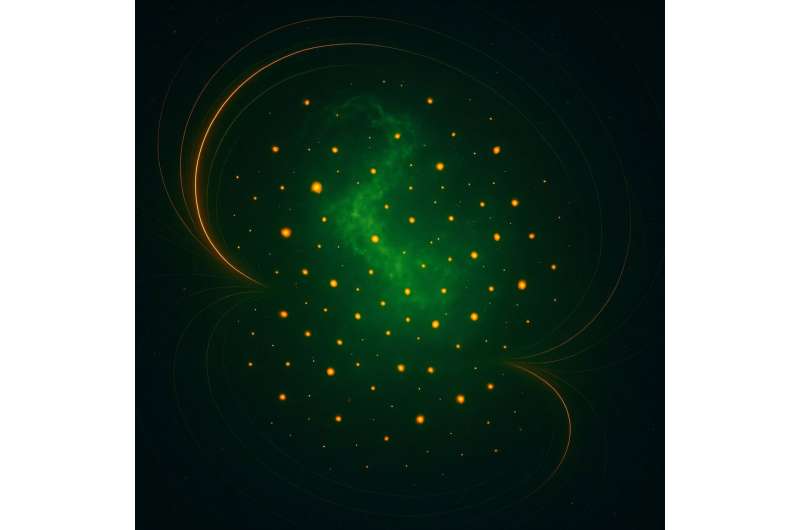
Rendering of dusty nanoparticles suspended in a glowing plasma cloud, where magnetic fields guide their motion and growth, showing how even weak magnetism can reshape matter at the nanoscale. Credit: Plasma Group, Department of Physics, Auburn University
Imagine a cloud that shines like a neon sign, but instead of raindrops, it contains countless microscopic dust grains floating in midair. This is a dusty plasma, a bizarre state of matter found both in deep space and in the laboratory.
In a new study, published this week in Physical Review E, Auburn University physicists report that even weak magnetic fields can reshape how these dusty plasmas behave—slowing down or speeding up the growth of nanoparticles suspended inside. Their experiments show that when a magnetic field nudges electrons into spiraling paths, the entire plasma reorganizes, changing how particles charge and grow.
“Dusty plasmas are like tiny particles in a vacuum box,” said Bhavesh Ramkorun, lead author of the study. “We found that by introducing magnetic fields, we could make these particles grow faster or slower, and the dust particles ended up with very different sizes and lifetimes.”
The researchers grew carbon nanoparticles by igniting a mix of argon and acetylene gas. Normally, particles grow steadily for about two minutes before drifting away. With magnetic fields, the cycle shortened dramatically—sometimes to under a minute—and the particles stayed smaller.
“It’s remarkable how sensitive the system is,” explained Saikat Thakur, co-author. “Electrons are the lightest players in the plasma, but when they become magnetized, they dictate the rules. That simple change can completely alter how nanomaterials form.”
The results could help scientists design new plasma-based techniques for creating nanoparticles with tailored properties for electronics, coatings, and quantum devices. At the same time, they offer fresh insight into natural plasmas in space, from planetary rings to the solar atmosphere, where dust and magnetic fields are constantly interacting.
“Plasma makes up most of the visible universe, and dust is everywhere,” added Ramkorun. “By studying how the smallest forces shape these systems, we’re uncovering patterns that connect the lab to the cosmos.”
More information:
Bhavesh Ramkorun et al, Electron magnetization effects on carbonaceous dusty nanoparticles grown in Ar−C2H2 capacitively coupled nonthermal plasma, Physical Review B (2025). DOI: 10.1103/3d3h-rkmb. On arXiv: DOI: 10.48550/arxiv.2504.21217
Provided by
Auburn University
Citation:
Magnetized plasmas offer a new handle on nanomaterial design (2025, October 21)
retrieved 22 October 2025
from https://phys.org/news/2025-10-magnetized-plasmas-nanomaterial.html
This document is subject to copyright. Apart from any fair dealing for the purpose of private study or research, no
part may be reproduced without the written permission. The content is provided for information purposes only.
